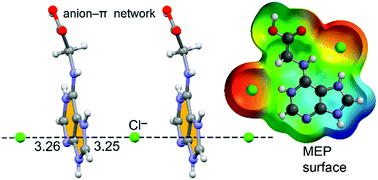In this manuscript, we report the synthesis and X-ray characterization of three N6-aminoacid/peptide–adenine-derivatives; the zwitterion N6GlyAde·0.5H2O (1), its corresponding protonated form N6GlyAde·2HCl·H2O (2) and N6GlyGlyAde·H2O (3). In the zwitterion complex (1), the adenine is protonated at N(3) and the anionic carboxylate interacts with the imidazole ring of the neighbouring purine molecule. It also interacts with the water molecule that connects it to another adenine ring through N(7)–H⋯O hydrogen bonds. The hydrochloride (compound 2) crystallizes forming a laminar structure and exhibits double protonation in the adenine ring (at N1 and N7). Moreover, energetically strong anion–π interactions are important for constructing the final solid state architecture in 2. Finally, compound 3, which presents a neutral adenine ring, crystallizes in a chiral point group and forms CH⋯O and CH⋯N H-bonding interactions in the solid state. We have also studied the noncovalent interactions energetically using DFT calculations and rationalized the interactions using Molecular Electrostatic Potential surfaces and Bader's theory of “Atoms-in-Molecules”.

